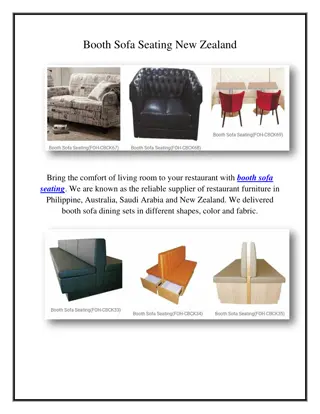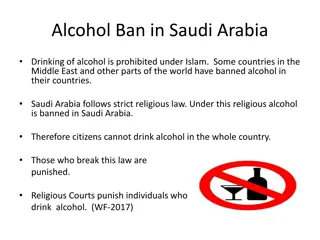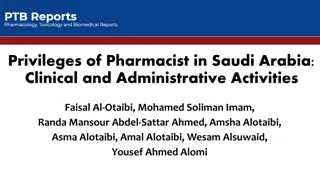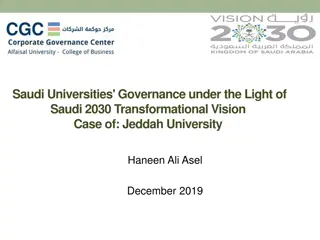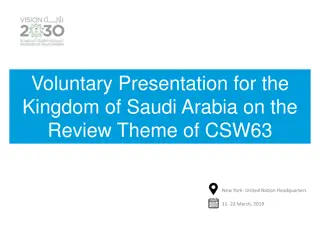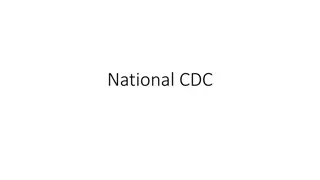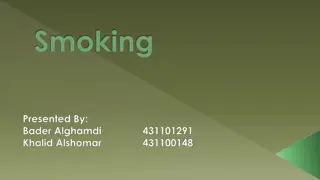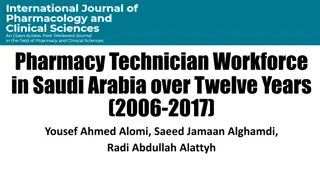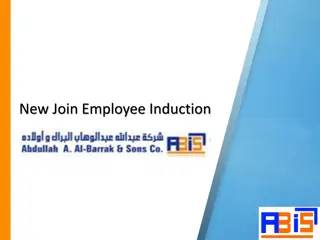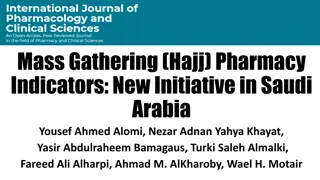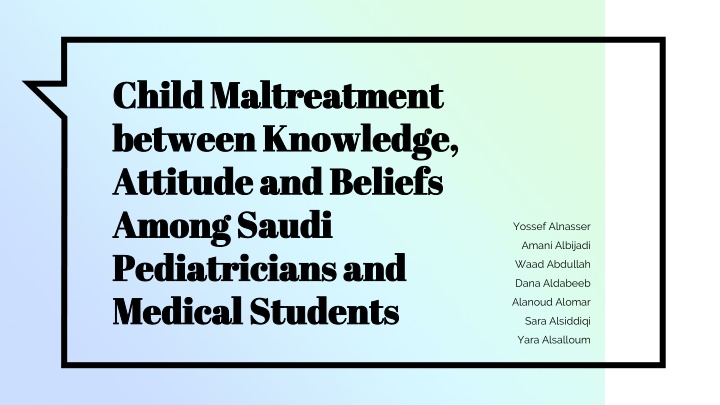
Child Maltreatment Among Saudi Pediatricians and Medical Students
Explore the knowledge, attitudes, and beliefs regarding child maltreatment among Saudi pediatricians, trainees, and medical students. The study aims to quantify their level of understanding, investigate the influence of religion and traditions, and test hypotheses about their knowledge and attitudes. This quantitative, observational study includes data collection through online questionnaires and analysis using SPSS software.
Download Presentation

Please find below an Image/Link to download the presentation.
The content on the website is provided AS IS for your information and personal use only. It may not be sold, licensed, or shared on other websites without obtaining consent from the author. If you encounter any issues during the download, it is possible that the publisher has removed the file from their server.
You are allowed to download the files provided on this website for personal or commercial use, subject to the condition that they are used lawfully. All files are the property of their respective owners.
The content on the website is provided AS IS for your information and personal use only. It may not be sold, licensed, or shared on other websites without obtaining consent from the author.
E N D
Presentation Transcript
Child Maltreatment Child Maltreatment between Knowledge, between Knowledge, Attitude and Beliefs Attitude and Beliefs Among Saudi Among Saudi Pediatricians Pediatricians and Medical Medical Students Students Yossef Alnasser Amani Albijadi and Waad Abdullah Dana Aldabeeb Alanoud Alomar Sara Alsiddiqi Yara Alsalloum
Child maltreatment is the abuse and neglect that occurs in children under 18 years of age. Introduction & Rationale In Saudi Arabia, the first case of child abuse was identified in 1990. Child maltreatment is not included in many medical schools and pediatric residency curriculums, which might limit knowledge and spread misconceptions.
To quantify level of knowledge and acceptance of child definitions. maltreatment Objectives To explore how do Saudi medical students, trainees and pediatricians feel about child maltreatment and reporting. To investigate impact of religion and traditions on beliefs maltreatment. toward child
Hypothesis We hypothesize that medical students and pediatric trainees have limited knowledge, oblivious attitude and misbeliefs regarding child maltreatment in comparison to experienced pediatricians. On the other hand, medical students and trainees might hold higher motives and willingness to learn about child maltreatment and their consequences.
Quantitative, observational, cross-sectional study. Methods Inclusion criteria: pediatricians, pediatrics trainees and medical students in different areas of pediatric services in King Saud University Medical City. Informed consent was obtained by stating the purpose of the study and assured the confidentiality of the responses.
Data Collection using self-administered online questionnaires in English which included Methods 1. 2. Socio-demographic characteristics. Questions to assess the level of knowledge and acceptance of child maltreatment. Pilot Study
Data Management Descriptive statistics were used to describe the categorical variables. Methods Data was analyzed using SPSS version 20.0 statistical software. Student t-test and chi-squared test were applied to assess the association between categorical study and outcome variables. A p-value of <0.05 was considered statistically significant.
Study Variables gender, level of physicians education and experience Methods Outcome Variables incidence of intention to report suspected cases of child abuse and neglect.
Parents psychiatric illnesses Parents poor education Parental drug abuse/Alcoholism Parental history of child Abuse Low Socio-economic class. Behavioral problems. Childs mental retardation Child's Chronic diseases Domestic violence Single Parent/divorced. Teen parenting 0 10 20 30 40 50 60 70 80 90 100 Identified Risk Factors of Child Abuse
Psychiatric illnesses. Abusive behavior. Poor academic performance. Poor Self Esteem. Pathological diseases (DM, obesity, hypertension etc.). Social difficulties. Alcohol and drug abuse. Poor cognitive outcome. Growth retardation. 0 10 20 30 40 50 60 70 80 90 100 Consequences of Child Maltreatment
NO. n(%) YES n(%) Question. I am familiar with the child abuse and neglect definition 30 (23.6 %) 97 (76.4%) The definition of CAN is subject to culture and traditions 86 (67.7%) 41 (32.3%) Child abuse and neglect happens in Saudi Arabia 2 (1.6 %) 125 (98.4%) CAN is a high priority among other social and health problems in Saudi Arabia 30 (23.6%) 97 (76.4%) Current Medical Schools provide good background about CAN 106 (83.5%) 21 (16.5%) Current Pediatric Residency Programs provided you a good background to deal with CAN situations 99 (77.9%) 28 (22%) A Saudi national program to protect against child abuse and neglect exists 83 (65.4%) 44 (34.6 %) Our hospital has a CPS process and structure in place 79 (62.2%) 48 (37.8%) Current Saudi Law Enforcement System is equipped to deal with cases of CAN 101 (79.5%) 26 (20.5%) I feel reporting child abuse and neglect should be made Mandatory" per professional code of practice 3 (2.4%) 124 (97.6%) My colleagues would hesitate in reporting suspected CAN subjects in general 66 (52 %) 61 (48 %) CAN is preventable 14 (11%) 113 (89%) I need further specialized training to deal with child abuse and neglect 8 (6.3 %) 119 (93.7%) I am willing to be trained to deal with victims of CAN. 10 (7.9 %) 117 (92.1%) ? Table 1. Knowledge, Attitude and Beliefs of Medical Students and Physicians
100 90 80 70 60 50 40 30 20 10 0 Emotional abuse Shaken infant syndrome Physical abuse Sexual abuse Commercial and human trafficking Neglect Medical students and physicians were more likely to report sexual and physical abuse
12.000 11.049 10.457 10.000 8.000 6.000 4.000 3.720 3.019 2.734 2.000 2.045 2.382 1.858 Odds Ratio .940 0.000 Multivariate Logistic Regression
7 6 5 4 3 2 1 0 Juniors Experienced physicians Number of identified risk factors Number of identified CAN consequences Recognition of Risk Factors and Consequences of CAN
In positive attitude and willingness to obtain further training were observed among study participants. general, good basic knowledge, Conclusion Experienced knowledgeable and more likely to report neglect. physicians were more Finally, higher enthusiasm to report and acquire further training. However, reporting is a major observed defect. female respondents showed
Our results do not represent the city of Riyadh as a whole, but are only limited to one hospital, lack generalizability. Limitations Data was collected in the form of self administered questionnaires, the responses could be affected with recall bias.
Further education and training are needed to combat Child Abuse and Neglect in Saudi Arabia. Recommendations
References 1. World Health Organization. Child abuse and neglect by parents and other caregivers. World Rep Violence Heal. 2002;59 86. 2. Gateway CWI. Long-term consequences of child abuse and neglect. 2013. 3. Akmatov MK. Child abuse in 28 developing and transitional countries-results from the multiple indicator cluster surveys. Int J Epidemiol. 2011;40(1):219 27. 4. Yehuda Y Ben, Attar-Schwartz S, Ziv A, Jedwab M, Benbenishty R. Child abuse and neglect: Reporting by health professionals and their need for training. Isr Med Assoc J. 2010;12(10):598 602. 5. Borres MP, H gg A. Child abuse study among Swedish physicians and medical students. Pediatr Int. 2007;49(2):177 82. 6. Chang A, Oglesby AC, Wallace HM, Goldstein H, Hexter AC. Child Abuse and Neglect : Physicians Knowledge , Attitudes , and Experiences. public Heal Br. 1976;66(12). 7. Feng JY, Chen YW, Fetzer S, Feng MC, Lin CL. Ethical and legal challenges of mandated child abuse reporters. Child Youth Serv Rev [Internet]. Elsevier Ltd; 2012;34(1):276 80. Available from: http://dx.doi.org/10.1016/j.childyouth.2011.10.026 8. Al Eissa M, Almuneef M. Child Abuse and Neglect in Saudi Arabia: Journey of recognition to implementation of national prevention strategies. Child Abus Negl. 2010;34(1):28 33. 9. Program NFS. Domestic Violence and Child Abuse and Neglect in Saudi Arabia Annual Report. www.nfsp.org.sa. 2014. p. 1 14.
References 10. Mogaddam M, Kamal I, Merdad L, Alamoudi N, Meligy O El, El-derwi D. Prevalence of Child Abuse in Saudi Arabia from 2000 to 2015 : A Review of the Literature. Oral Hyg Heal. 2015;3(6):1 4. 11. Al-Eissa YA. Child abuse and neglect in Saudi Arabia: What are we doing and where do we stand? Ann Saudi Med. 1998;18(2):105 6. 12. Wright RJ, Wright RO, Farnan L, Isaac NE. Response to child abuse in the pediatric emergency department: need for continued education. Pediatric emergency care. 1999. p. 376 82. 13. Al-Shail E, Hassan A, Aldowaish A, Kattan H. The Cultural Reinforcers of Child Abuse. Child Abus Negl - A Multidimens Approach. 2012;20 38. 14. Fadheela Taher Al-Mahroos. Child abuse and neglect in the Arab Peninsula. Saudi Med J. 2007;(July):241 8. 15. Almuneef M, Al-Eissa M. Preventing child abuse and neglect in Saudi Arabia: Are we ready. Ann Saudi Med. 2011;31(6):635 40. 16. Lane WG, Dubowitz H. Primary care pediatricians experience, comfort and competence in the evaluation and management of child maltreatment: Do we need child abuse experts? Child Abus Negl. 2009;33(2):76 83. 17. Jaudes PK, Mackey-Bilaver L. Do chronic conditions increase young children s risk of being maltreated? Child Abus Negl. 2008;32(7):671 81. 18. Sullivan, P.M.,& Knutson JF. Maltreatment and Disabilities : a Population- Based Epidemiological Study. Child Abus Negl. 2000;24(10):1257 73.
References 19. Glasser S, Chen W. Survey of a pediatric hospital staff regarding cases of suspected child abuse and neglect. Isr Med Assoc J. 2006;8(3):179 83. 20. Biehler JL, Apolo J, Burton L. Views of pediatric emergency fellows and fellowship directors concerning training experiences in child abuse and neglect. Pediatric emergency care. 1996. p. 365 9. 21. Al-Dabaan R, Newton JT, Asimakopoulou K. Knowledge, attitudes, and experience of dentists living in Saudi Arabia toward child abuse and neglect. Saudi Dent J [Internet]. King Saud University; 2014;26(3):79 87. Available from: http://dx.doi.org/10.1016/j.sdentj.2014.03.008 22. Habib HS. Pediatrician knowledge, perception, and experience on child abuse and neglect in Saudi Arabia. Ann Saudi Med. 2012;32(3):236 42. 23. Fung DS, Chow MH. Doctors and lawyers' perspectives of child abuse and neglect in Singapore.[Erratum appears in Singapore Med J 1998 Jul;39(7):299]. Singapore Med J [Internet]. 1998;1 7. Available from: http://ovidsp.ovid.com/ovidweb.cgi?T=JS&CSC=Y&NEWS=N&PAGE=fulltext&D=med4&AN=9676146 24. Ashoor L, Al F, Grant N. Children abuse: Factors affecting case reporting by physicians. Bahrain Med Bull. 2012;34(3). 25. Alsehaimi A. A Systematic Review of Literature on Child Sexual Abuse in Saudi Arabia. iMedPub Journals. 2016;1 5. 26. Newton AW, Vandeven AM. Child abuse and neglect: a worldwide concern. Curr Opin Pediatr [Internet]. 2010;22(2):226 33. Available from: http://www.ncbi.nlm.nih.gov/pubmed/20164772 27. AlMadani O, Bamousa M, Alsaif D, Kharoshah MAA, Alsowayigh K. Child physical and sexual abuse in Dammam, Saudi Arabia: A descriptive case-series analysis study. Egypt J Forensic Sci [Internet]. Forensic Medicine Authority; 2012;2(1):33 7. Available from: http://dx.doi.org/10.1016/j.ejfs.2012.01.001 28. Elayyan K. Violance Against Children Jordan Study. UNICEF. 2007.
You treat a disease, you win, you lose. You treat a person, I guarantee you, you will win, no matter what the outcome. -Patch Adams
Thanks! Any questions? You can find me at sara.alsiddiqi@gmail.com







